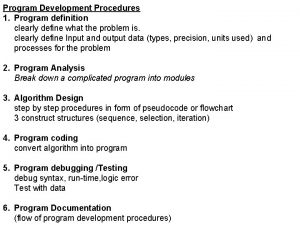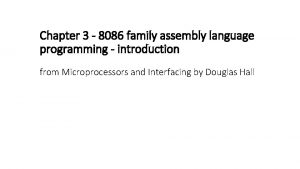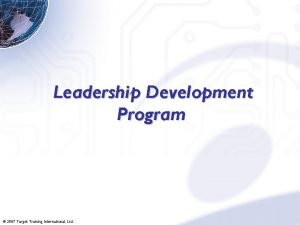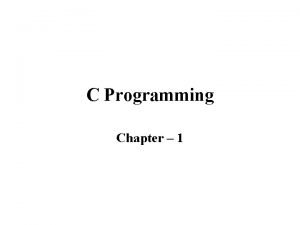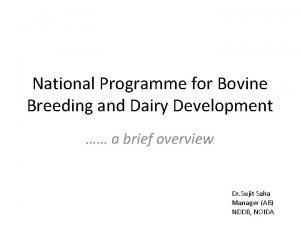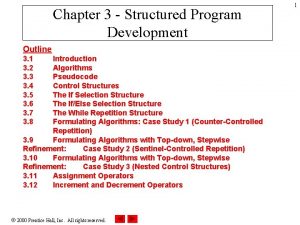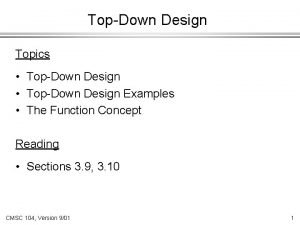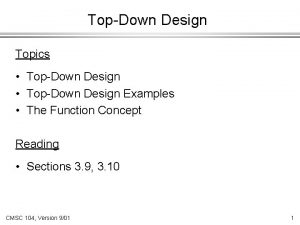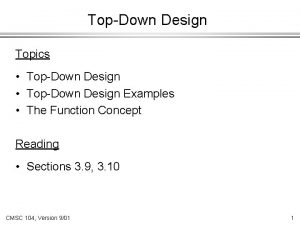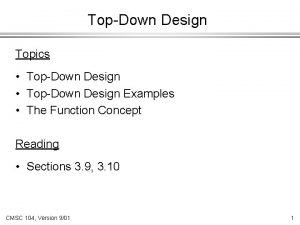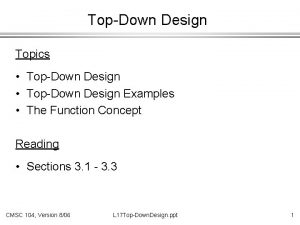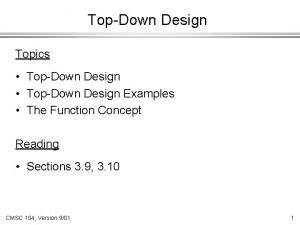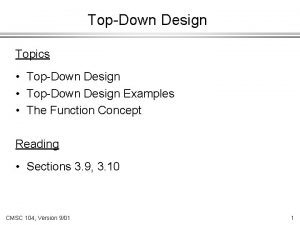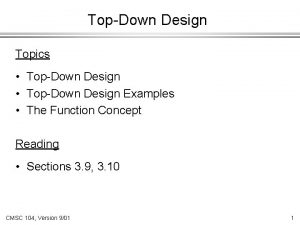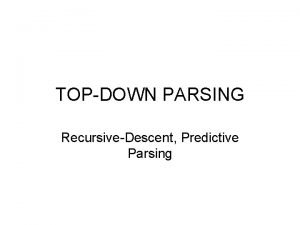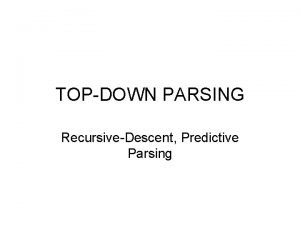TopDown Design 2 Program Development 1 TopDown Design














- Slides: 14

Top-Down Design 2. Program Development 1 Top-Down Design: A solution method where the problem is broken down into smaller sub-problems, which in turn are broken down into smaller subproblems, continuing until each sub-problem can be solved in a few steps. (Also called: Divide and Conquer strategy) Problem: An integer N is "perfect" if N is equal to the sum of the positive integers K such that K < N and K is a divisor of N. Design an algorithm to determine if a given integer is "perfect". The top-level sub-problems (or tasks) appear to be: I. III. Get the number which is to be tested. Determine the divisors of the number. Check if the divisors add up to the number. Now we may consider each of these tasks separately, assuming the others will be taken care of… Computer Science Dept Va Tech August 2002 Intro Programming in C++ © 2002 Barnette ND & Mc. Quain WD

Top-Down Analysis Example 2. Program Development 2 Continuing our analysis: I. Get the number which is to be tested. A. Output a prompt asking for the number. B. Input the number; call it N. C. Stop if N isn't positive. II. Determine the divisors of the number. A. Set the divisor sum to 1. (Since 1 certainly divides N. ) B. Check each integer, D, from 2. . . N/2 to see if D is a divisor of N. III. Check the results. A. If the divisor sum equals N Then i. N is perfect Else i. N is not perfect. Now we may consider what details need to be added to clarify the process enough to make it an algorithm. Computer Science Dept Va Tech August 2002 Intro Programming in C++ © 2002 Barnette ND & Mc. Quain WD

Top-Down Analysis Example 2. Program Development 3 Continuing to add detail: I. Get the number which is to be tested. A. Output: "Please enter a positive integer: " B. Input the number; call it N. C. If N isn't positive i. Output: N " isn't perfect. " ii. STOP. II. Determine the divisors of the number. A. Set the Divisor. Sum to 1. (Since 1 certainly divides N. ) B. Set D to 2. C. While D is less than or equal to N / 2 i. If D is a divisor of N The outline format used a. Add D to Divisor. Sum here is a fairly simple ii. Add 1 to D. way to express an III. Check the results. A. If Divisor. Sum equals N i. Output: N " is perfect. " Else i. Output: N " isn't perfect. " B. STOP. Computer Science Dept Va Tech August 2002 Intro Programming in C++ algorithm design. It clarifies the ordering and grouping of actions, and doesn't require any special editing tools to create. © 2002 Barnette ND & Mc. Quain WD

Why Practice Top-Down Design? 2. Program Development 4 One of the most fundamental ideas in problem solving involves subdividing a problem into subproblems and solving each subproblem individually. Quite often, the attempt to solve a subproblem introduces new subproblems at a lower level. The subdivision of subproblems should continue until a subproblem can easily be solved. This is similar to the refining of an algorithm. In large projects, subproblems may be assigned to different programmers, or teams, who will be given precise guidelines about how that subproblem fits into the overall solution, but who will have relatively complete freedom in attacking the particular subproblem at hand. If there is a problem you can't solve, then there is an easier problem you can't solve: find it. G. Pólya Computer Science Dept Va Tech August 2002 Intro Programming in C++ © 2002 Barnette ND & Mc. Quain WD

Representing Designs 2. Program Development 5 Most common techniques: 1. Outlining (written decomposition) 2. Structure Chart (hierarchical tree diagram) 3. Pseudocode (mixture of English & programming constructs) Structure chart for the Perfect Number Algorithm: Perfect Number Algorithm Get the number N Output a prompt Determine the divisors of N Set Sum to 1 Check the result If Sum equals N Output N is perfect Read N If N <= 1 Output N isn't perfect STOP Set D to 2 While D <= N / 2 else Output N isn't perfect If D is a divisor of N Add D to Sum Add 1 to D Computer Science Dept Va Tech August 2002 Intro Programming in C++ © 2002 Barnette ND & Mc. Quain WD

Pseudocode Representation 2. Program Development 6 Comment Get the value for N Output: “Please enter a positive integer: ” Input: N If N <= 0 Then Output: N “ isn't a perfect number. ” STOP Endif Comment Initialize sum of the divisors & divison Sum. Of. Divisors <-- 1 Candidate <-- 2 Comment Consider all possible divisors While Candidate <= N / 2 Do R <-- N - (Truncate ( N / Candidate ) )* Candidate If R = 0 Then Sum. Of. Divisors <-- Sum. Of. Divisors + Candidate Endif Candidate <-- Candidate + 1 Pseudocode is Endwhile Comment Check the results If Sum. Of. Divisors = N Then Output: N “ is a perfect number. ” Else Output: N “ isn't a perfect number. ” Endif Computer Science Dept Va Tech August 2002 Intro Programming in C++ potentially clearer than either a structure chart or an outline. Unfortunately there is no universal pseudocode notation. © 2002 Barnette ND & Mc. Quain WD

Proofs of Program Correctness 2. Program Development 7 Program proof: code analysis to achieve a formal verification of the correctness of a program's output. Assertion: statement of a relationship between a program's variables and data. • Every program statement can be preceded and succeeded by an assertion, (termed the precondition and postcondition respectively). • Program proofs involve applying deductive logic to show that the precondition and postcondition assertions are true for all program statements • Due to practical time considerations assertions are made and proven only for sequences of statements. Example: // Pre: M >= 0, N > 0 precondition while (M > 0) M = M / N; // Post: M == 0, N > 0 Computer Science Dept Va Tech August 2002 Intro Programming in C++ postcondition © 2002 Barnette ND & Mc. Quain WD

Invariants 2. Program Development loop invariants 8 assertions that are true prior to loop execution and following each loop iteration. Commonly composed of the boolean expression controlling the loop, its negation, ranges of loop variables, data structure states and file status. Derived by analyzing the setup and modifications of the loop variables. Example: . . . // Integer multiplication by repeated addition. // Calculates Multiplier * Multiplicand stores result in // Product. // Pre: Multiplier >= 0, Multiplicand has been set Product = 0; Factor = Multiplier; // Invariants: Product == Multiplicand * (Multiplier - Factor) // Factor is in the range [0, Multiplier] while (Factor > 0) { Product = Product + Multiplicand; Factor = Factor - 1; } // Post: Product == Multiplier * Multiplicand // Factor == 0. . . Computer Science Dept Va Tech August 2002 Intro Programming in C++ © 2002 Barnette ND & Mc. Quain WD

Program Documentation 2. Program Development 9 The production of external program documentation prior to program implementation is a natural outgrowth of any good software development process. External documentation describes the purpose of a program and its data. External documentation may also describe the overall architecture of the program design. Internal documentation, in the form of in-line comments, as well as module documentation, is produced in conjunction with code development. The production of good documentation should be viewed as a necessary and useful part of the software development process, not merely as an afterthought to satisfy requirements. A student's curator submission that receives the highest score will be graded for adherence to documentation requirements, whether it is the last submission or not. If two or more submissions are tied for highest, the earliest will be graded. Therefore: implement and comment your C++ source code from the beginning rather than planning to clean up and add comments later. There are no exceptions to this policy! See the “Elements of Programming Style” in the appendices. Computer Science Dept Va Tech August 2002 Intro Programming in C++ © 2002 Barnette ND & Mc. Quain WD

Structure Chart 2. Program Development 10 A structure chart is a documentation tool that enables the designer to keep track of the relationships among subproblems throughout this refinement process. The structure chart gives a detailed description of the original problem in terms of subproblems. This top-down description will make it easier to write a program to solve the original problem. We can solve each upper-level box in the structure chart by using a C++ function. A function is a grouping of statements into a single unit. This single unit can be invoked to solve its subproblem simply by activating it by means of a function call. Since the structure chart gives a pictorial mechanism for visualizing the solution to a problem and each of the pieces of the structure chart corresponds to a function, the solution to a problem is obtained by correctly invoking a series of functions. In order to solve problems, we need only solve all the subproblems by means of functions. Thus a C++ program is a collection of functions that solve a series of subproblems. This is the essence of top-down design. Computer Science Dept Va Tech August 2002 Intro Programming in C++ © 2002 Barnette ND & Mc. Quain WD

Procedural Abstraction 2. Program Development 11 The top-down approach to program design involves procedural abstraction. This enables us to associate meaningful names with more complicated algorithm steps, reference these steps by name, and defer their implementation details until later. Our programs are written using logically independent sections, similar to the manner in which we developed the solution algorithm (as logically independent steps). Using logically independent program sections enables the programmer to hide the details of subproblem implementations from one another. This concept, information hiding, is critical in all stages of the software development process. Computer Science Dept Va Tech August 2002 Intro Programming in C++ © 2002 Barnette ND & Mc. Quain WD

Categories of Programming Errors 2. Program Development 12 Language syntax (compilation) errors: - Error is in the form of the statement: misspelled word, unmatched parenthesis, comma out of place, etc. - Error is detected by the compiler (at compile time). - Compiler cannot correct error, so no object file is generated. - Compiler prints error messages, but usually continues to compile. Linking errors: - Error is typically in the form of the declaration or implementation or call of a function. - Error may also result from including the wrong header file. - Error is detected by the linker (after the compiler has produced an object file). - Linker cannot correct error, so no executable file is generated. - Linker prints error messages, but usually continues link analysis. Computer Science Dept Va Tech August 2002 Intro Programming in C++ © 2002 Barnette ND & Mc. Quain WD

Categories of Programming Errors 2. Program Development 13 Execution (runtime) errors: - Error occurs while the program is running, causing the program to "crash" (terminate abnormally) and usually producing an error message from the operating system. - Error is frequently an illegal operation of some sort. The most common are arithmetic errors like an attempt to divide by zero, and access violations when the program tries to use some resource like a memory address that is not allocated to it. - Program source code compiles and links without errors – no help there. - Unfortunately, some operating systems do not reliably detect and respond to some kinds of execution errors. In that case, an incorrect program may appear to function correctly on one computer but not on another. Logic errors: - Error occurs while the program is running, causing the production of incorrect results, but not necessarily a runtime "crash". - Program source code compiles and links without errors – no help there. - Logic errors are detected by checking results computed by the program. - The cause(s) of the error must be determined by a logical analysis of the error and the source code. This must be done by the developer. This is the hardest type of error to deal with. Computer Science Dept Va Tech August 2002 Intro Programming in C++ © 2002 Barnette ND & Mc. Quain WD

The Program Development Process 2. Program Development 14 Analyze the problem statement Design a solution Enter/edit source code Find error in source code check syntax Compile/link source code Compiler/Linker errors? yes no Test the program Execution errors? yes no Results incorrect? Computer Science Dept Va Tech August 2002 yes no Intro Programming in C++ Find cause of runtime error check code or check input data rethink analysis/design Find cause of logic error check code check input data rethink analysis/design or Success! At least with this input. © 2002 Barnette ND & Mc. Quain WD
 Top-down processing vs bottom-up processing
Top-down processing vs bottom-up processing Community development means
Community development means Development that ended much development crossword
Development that ended much development crossword What are the two types of pattern development
What are the two types of pattern development Define program development
Define program development Professional development program, rockefeller college
Professional development program, rockefeller college Gallo management development program
Gallo management development program Assembly language programming 8086
Assembly language programming 8086 Leadership development program template
Leadership development program template Target training international
Target training international Fulbright faculty development program
Fulbright faculty development program Artisan development program
Artisan development program Program development steps in c
Program development steps in c Npbb full form
Npbb full form Program development outline
Program development outline




